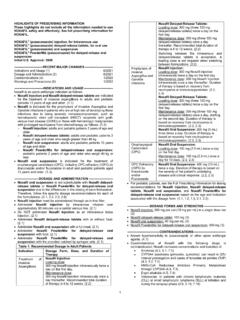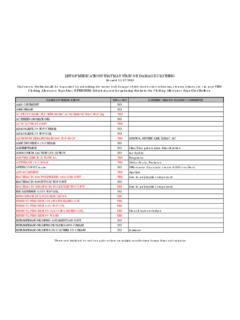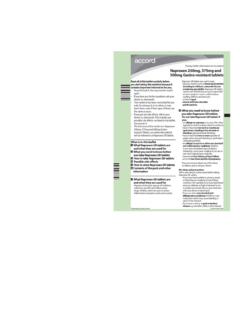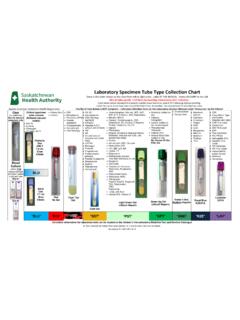Transcription of ANNEX I SUMMARY OF PRODUCT CHARACTERISTICS
1 1 ANNEX ISUMMARY OF PRODUCT CHARACTERISTICS2 This medicinal PRODUCT is subject to additional monitoring. This will allow quick identification of new safety information. Healthcare professionals are asked to report any suspected adverse reactions. See section for how to report adverse OF THEMEDICINAL PRODUCTRINVOQ15 mg prolonged-release tabletsRINVOQ 30 mg prolonged-release tabletsRINVOQ 45 mg prolonged-release AND QUANTITATIVE COMPOSITIONRINVOQ 15 mg prolonged-release tabletsEach prolonged-release tablet contains upadacitinib hemihydrate, equivalent to 15mg of 30 mg prolonged-release tabletsEach prolonged-release tablet contains upadacitinib hemihydrate, equivalent to 30mg of 45mg prolonged-release tabletsEach prolonged-release tablet contains upadacitinib hemihydrate, equivalent to 45 mg of the full list of excipients, see section FORMP rolonged-releasetabletRINVOQ 15mg prolonged-release tabletsPurple 14 x 8mm,oblong biconvex prolonged-release tablets imprinted on one side with a15.
2 RINVOQ 30 mg prolonged-release tabletsRed 14 x 8mm,oblong biconvex prolonged-release tablets imprinted on one side with a30 .RINVOQ 45mg prolonged-release tabletsYellowto mottled yellow14 x 8mm,oblong biconvex prolonged-release tablets imprinted on one side with a45 . indicationsRheumatoid arthritisRINVOQis indicated for the treatment of moderate to severe active rheumatoid arthritis in adult patients who have responded inadequately to, or who are intolerant to one or more disease-modifying anti-rheumatic drugs(DMARDs). RINVOQmay be used as monotherapy or in combination with arthritisRINVOQ is indicated for the treatment of active psoriatic arthritis in adult patients who have responded inadequately to, or who are intolerant to one or more DMARDs. RINVOQ may be used as monotherapy or in combination with spondyloarthritisNon-radiographic axial spondyloarthritis (nr-axSpA)RINVOQ is indicated for the treatment of active non-radiographic axial spondyloarthritis in adult patients with objective signs of inflammation as indicated by elevated C-reactive protein (CRP) and/or magnetic resonance imaging (MRI),who have responded inadequately to nonsteroidal anti-inflammatory drugs (NSAIDs).
3 Ankylosing spondylitis(AS, radiographicaxial spondyloarthritis)RINVOQ is indicated for the treatment of active ankylosing spondylitis in adult patients who have responded inadequately to conventional dermatitisRINVOQ is indicated for the treatment of moderateto severe atopic dermatitis in adults and adolescents 12 years and older who are candidates for systemic colitisRINVOQ is indicated for the treatment of adult patients with moderately to severely active ulcerative colitis who have had an inadequate response, lost response or were intolerant to either conventional therapy or a biologic and method of administrationTreatment with upadacitinibshould be initiated and supervised by physicians experienced in the diagnosis and treatment of conditions for which upadacitinib is arthritis, psoriatic arthritis and axial spondyloarthritisThe recommended dose ofupadacitinibis 15mg once should be given to discontinuing treatment in patients withaxial spondyloarthritiswho have shown no clinical response after 16 weeks of treatment.
4 Some patients with initial partial response may subsequently improve with continued treatment beyond 16 dermatitisAdultsThe recommended dose of upadacitinib is 15mg or 30mg once daily based on individual patient presentation. A dose of 30mg once daily may be appropriate for patientswith highdisease burden. A dose of 30mg once daily may be appropriate for patients with an inadequate response to15 mg once daily. The lowest effective dose for maintenance should be patients 65 years of age, the recommended dose is 15mg once (from 12 to 17 years of age)The recommended dose of upadacitinib is 15mg once daily for adolescents weighing at least topical therapiesUpadacitinibcan be used with or without topical corticosteroids. Topical calcineurin inhibitors may be used for sensitive areas such as the face, neck, and intertriginous and genital should be given to discontinuing upadacitinib treatment in any patient who shows no evidence of therapeutic benefit after 12 weeks of colitisInductionThe recommended induction dose of upadacitinib is 45mg once dailyfor 8 weeks.
5 For patients who do not achieve adequate therapeutic benefit by week 8, upadacitinib 45mg once daily may be continued for an additional 8 weeks(see sections and ). Upadacitinib should be discontinued in any patient who shows no evidence of therapeutic benefit by week recommended maintenance dose of upadacitinib is 15 mg or 30mg once daily based on individual patient presentation: A dose of 30mg once daily may be appropriate for some patients, such as those with high disease burden or requiring 16-week inductiontreatment. A dose of 30mg once daily may be appropriate for patients who do not show adequate therapeutic benefit to 15mg once daily. The lowest effective dose for maintenance shouldbe patients 65 years of age, the recommended dose is 15 mg once daily. In patients who have responded to treatment with upadacitinib, corticosteroids may be reduced and/or discontinued in accordance with standard of patients with ulcerative colitis receiving strong inhibitors of cytochrome P450 (CYP) 3A4 ( , ketoconazole, clarithromycin), the recommended induction dose is 30mg once daily and the recommended maintenance dose is 15mg once daily (see section ).
6 Dose initiationTreatment should not be initiated in patients with an absolute lymphocyte count (ALC) that is < x 109cells/L, an absolute neutrophil count (ANC) that is < 1 x 109cells/Lor who have haemoglobin (Hb) levels that are <8 g/dL (see sections and ).Dose interruptionTreatment should be interrupted if a patient develops a serious infection until the infection is of dosing may be needed for management of laboratory abnormalities as described in Table Laboratory measures and monitoring guidanceLaboratory measureActionMonitoring guidanceAbsolute Neutrophil Count (ANC)Treatment should be interrupted if ANC is < 1 x 109cells/L and may be restarted once ANC returns above this valueEvaluate at baseline and then no later than12 weeks after initiation of treatment. Thereafter evaluate according to individual patient Lymphocyte Count (ALC)Treatment should be interrupted if ALC is < x 109cells/L and may be restarted once ALC returns above this valueHaemoglobin (Hb)
7 Treatment should be interrupted if Hb is < 8 g/dL and may be restarted once Hb returns above this valueHepatic transaminasesTreatment should be temporarily interrupted if drug-induced liver injury is suspectedEvaluate at baseline and thereafter according to routine patient should be managed according to international clinical guidelines for hyperlipidaemiaEvaluate 12 weeks after initiation of treatment and thereafter according to international clinical guidelines for hyperlipidaemiaSpecial populationsElderlyRheumatoid arthritis, psoriatic arthritis, axial spondyloarthritisThere are limited data in patients aged 75 years and dermatitisFor atopic dermatitis, doses higher than 15mg once daily are not recommended in patients aged 65 yearsand older(see section ).Ulcerative colitisFor ulcerative colitis, doses higher than15 mg once daily for maintenance therapy are not recommended in patients aged 65years and older(see section ).
8 The safety and efficacy of upadacitinibin patients aged 75 and olderhave not yet been impairmentNo dose adjustment is required in patients with mild or moderate renal impairment. There are limited data on the use of upadacitinib in subjects with severe renal impairment (see section ). Upadacitinib should be used with caution in patients with severe renal impairmentas described in Table 2. The use of upadacitinibhas not been studied in subjects with end stage renal diseaseand is therefore not recommended for use in these 2 Recommended dosefor severe renal impairmentaTherapeutic indicationRecommended once daily doseRheumatoid arthritis, psoriatic arthritis, axial spondyloarthritis, atopic dermatitis 15 mgUlcerative colitisInduction: 30mgMaintenance: 15mgaestimated glomerular filtration rate (eGFR) 15 to <30 ml/ impairmentNo dose adjustment is required in patients with mild (Child-Pugh A) or moderate (Child-Pugh B) hepatic impairment(see section ).
9 Upadacitinib shouldnot be used in patients with severe (Child-Pugh C) hepatic impairment (see ).Paediatric populationThe safety and efficacy of RINVOQ in children with atopic dermatitis below the age of 12years have not been established. No data are available. No clinical exposure data are available in adolescents < 40 kg (see section ).The safety and efficacy of RINVOQin children and adolescents with rheumatoid arthritis, psoriatic arthritis, axial spondyloarthritis and ulcerative colitisaged 0to less than 18 years have not yet been established. No data are of administrationRINVOQis to be taken orally once daily with or without food and may be taken at any time of the day. Tablets should be swallowed whole and should not be split, crushed, or chewedin order to ensure the entire dose is delivered Hypersensitivity to the active substanceor to any of the excipients listed in section Active tuberculosis (TB) or active serious infections (see section ).
10 Severe hepatic impairment (see section ). Pregnancy (see section ). warnings and precautions for useImmunosuppressive medicinal productsCombination with other potent immunosuppressants such as azathioprine, 6-mercaptopurine,ciclosporin, tacrolimus , and biologic DMARDs or otherJanus kinase (JAK) inhibitors has not been evaluated in clinical studies and is not recommended as a risk of additive immunosuppression cannot be infectionsSerious and sometimes fatal infections have been reported in patients receiving upadacitinib. The most frequent serious infections reported with upadacitinibincluded pneumoniaand cellulitis(see ).Cases of bacterial meningitis have been reported in patients receiving opportunistic infections, tuberculosis, multidermatomal herpes zoster, oral/oesophageal candidiasis, and cryptococcosis were reported with not be initiated in patients with an active, serious infection, including localised the risks and benefits of treatment prior to initiating upadacitinib in patients: with chronic or recurrent infection who have been exposed to tuberculosis with a history of a serious or an opportunistic infection who have resided or travelledin areas of endemic tuberculosis or endemic mycoses; or with underlying conditions that may predispose them to should be closely monitored for the development of signs and symptoms of infection during and after treatment with upadacitinib.














